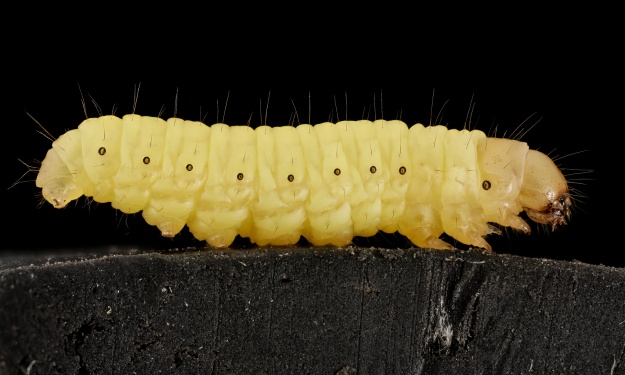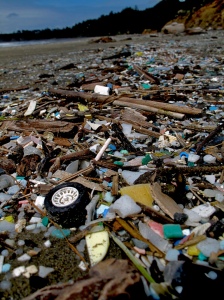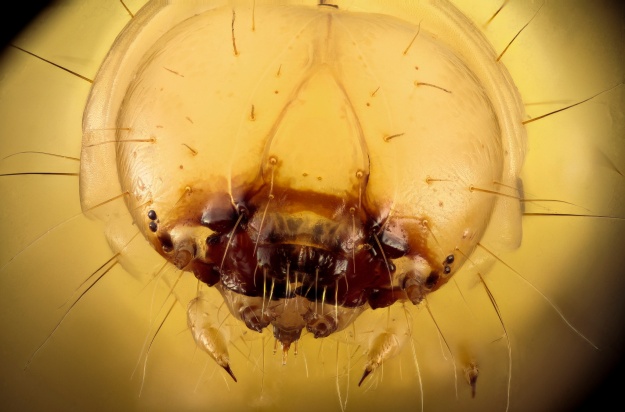By Roberta Attanasio, IEAM Blog Editor

Wax worm (Galleria mellonella). Credit: , .
“Like diamonds, plastics are forever,” began a recent New York Times . Or are they? No one knows exactly how long it takes for conventional plastics to completely degrade—it could be hundreds or thousands of years. In other words, a very long time. Even when broken down, plastics persist as tiny bits called microplastics.

Beach plastic, Otter Rock, Oregon, USA. Credit: , .
The first global analysis of the production, use, and fate of all plastics ever made in July 2017. The study shows that by 2015, humans generated 8.3 billion metric tons of plastics. Of these, 6.3 billion tons had already become waste. Only 9% of the waste was recycled, 12% was incinerated, and 79% accumulated in landfills or the natural environment. These staggering numbers explain why it is necessary to find strategies to degrade accumulated plastics.
A published in Current Biology raised considerable interest in those seeking to limit the impact of plastic pollution. Science journalists jumped on the wagon, and rightly so—the study results promised a possible solution to the accumulation of plastic bags. Worldwide, are used each year, 380 billion of which are used in the United States alone. Most plastic bags are not recycled. Journalists were also captivated by the story leading to the study, which was widely reported in the news.
As the story goes, Federica Bertocchini, a scientist in the field of embryo early development at the Spanish National Research Council and amateur beekeeper, found wax worms in the honeycombs of her hives. Wax worms, one of the beekeepers’ scourge, are the caterpillar larvae of Galleria mellonella, which feed on the wax that bees use to build their honeycombs. While cleaning the hives, Bertocchini placed the worms in a typical plastic shopping bag. Plastic bags and plastic packaging are mostly made up of polyethylene. To her surprise, the worms made holes in the plastic bag and made their way out.

Bee sealing honey cells with wax. Credit: , .
The worms’ escape piqued Bertocchini’s interest; she wanted to find out whether they were chewing the plastic or breaking it down through a chemical process. To answer her question, she collaborated with biochemical scientists at the University of Cambridge. The scientists crushed the larvae in a blender and smeared the resulting paste on polyethylene plastic. After half a day, about 13% of the treated plastic dissolved, indicating that plastic degradation was the result of an enzyme or a combination of enzymes present within the larvae. In addition, the scientists observed that the degradation was extremely fast compared with that of isolated from another type of wax worm.
The scientists then carried out infrared spectroscopic analysis and found that the larvae were capable of breaking the polyethylene chemical bonds, transforming the polyethylene into ethylene glycol. Paolo Bombelli, first author of the study, that the caterpillar produces something that breaks the chemical bonds, perhaps in its salivary glands. Alternatively, symbiotic bacteria in its gut could be responsible for breaking the bonds. He added that the next step would be the identification of the molecular processes and the enzymes involved in the breakage.

Wax worm. Credit: , .
The study has generated controversy since its publication. Initially, were related to the breeding of caterpillars—necessary to digest the plastics— and the potential damage they could inflict on bee colonies, ultimately putting crops at risk. However, Bertocchini and collaborators plan to identify the enzymes responsible for breaking down the polyethylene, so they could be produced at high-scale and used for plastic degradation; this process would not require exposure of plastics to caterpillars.
A few days ago, a team of scientists at the Johannes Gutenberg University Mainz (Germany) that the interpretation of results obtained by Bertocchini and collaborators using infrared spectroscopic analysis is questionable. They note that the experiments were carried out without proper controls and raise doubts about the actual detection of ethylene glycol. An accompanying states that “the sensational report of plastic eating caterpillars at least appears highly doubtful.”
Bertocchini and her collaborators , while recognizing that the additional studies proposed by the German team would help to confirm the polyethylene breakdown and more accurately identify the nature of the breakdown products.
However, they believe that the fact that polypropylene is broken down at all is more significant for their initial study than the precise nature of the breakdown products.
What are the additional studies proposed by the German team? They propose labeling polyethylene with a molecular tag, so it would be possible to follow the formation of metabolites in the worm resulting from its digestion.
Carrying out the additional experiments with the molecular tag—while identifying the enzymes involved in the breakdown of polyethylene—seems a prudent solution to squelch the controversy and make the plastic-eating caterpillars the starring actors of a success story.
